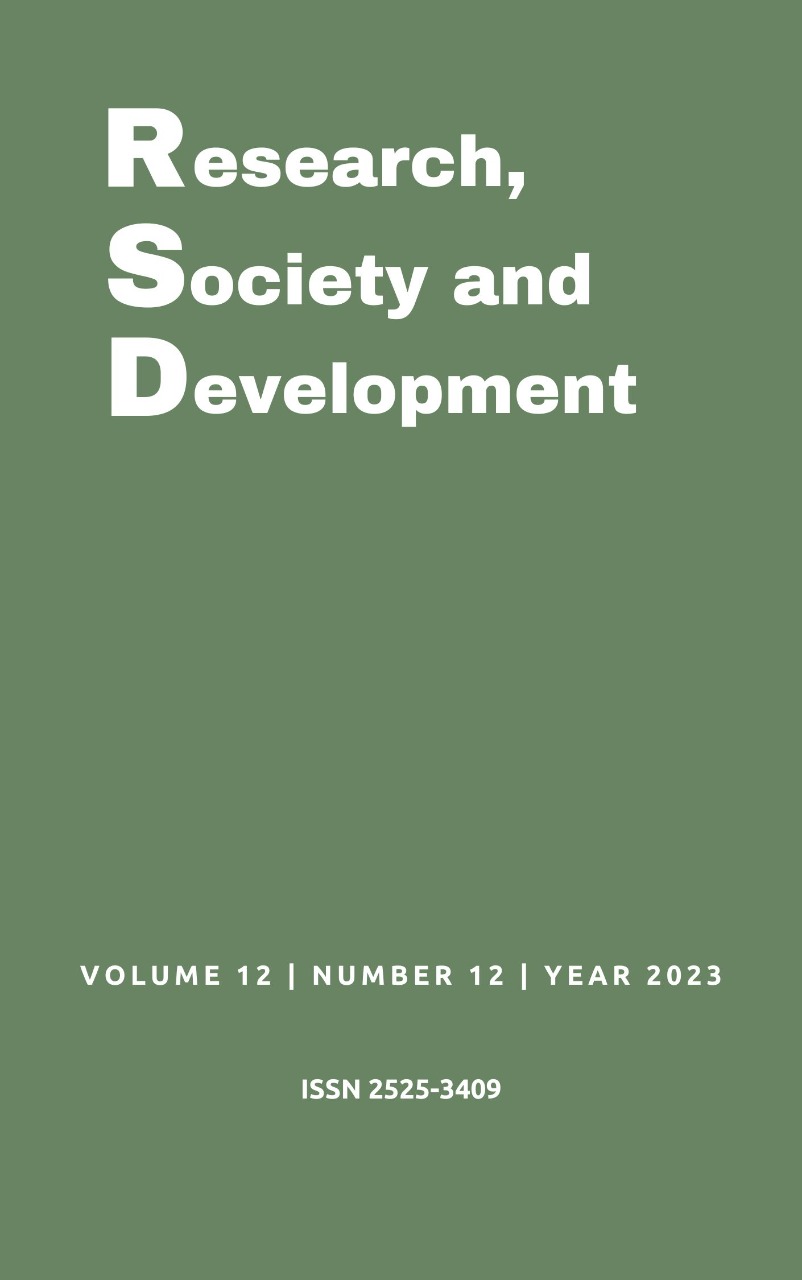Toxina botulínica terapêutica na harmonização orofacial
DOI:
https://doi.org/10.33448/rsd-v12i12.44066Palavras-chave:
Toxinas Botulínicas Tipo A; Dor Facial; Bruxismo.Resumo
A harmonização orofacial, uma especialidade da odontologia, visa melhorar a estética facial e a função dos músculos, ossos e tecidos moles na região da boca e do rosto. A toxina botulínica desempenha um papel importante nessa prática, sendo aplicada cirurgicamente ou não para aliviar problemas como bruxismo e dor crônica. O uso da toxina botulínica tem ganhado aceitação na odontologia devido à sua eficácia na redução da tensão muscular facial. Para pacientes com bruxismo, a toxina botulínica temporariamente paralisa os músculos da mastigação, aliviando a pressão sobre os dentes e reduzindo o desgaste dental. Além disso, ela é útil no tratamento de condições como disfunção temporomandibular (DTM) e enxaquecas tensionais, proporcionando alívio. No entanto, é fundamental que os profissionais da harmonização orofacial tenham conhecimento anatômico e experiência clínica em procedimentos com toxina botulínica para garantir resultados seguros. A prática deve seguir diretrizes éticas e legais para a segurança e bem-estar dos pacientes. A integração da toxina botulínica na odontologia, no contexto da harmonização orofacial, representa uma abordagem inovadora com potencial para melhorar a saúde e a qualidade de vida de pacientes que enfrentam condições faciais dolorosas e disfuncionais. Para tanto, o objetivo deste trabalho de revisão narrativa da literatura é investigar a associação da toxina botulínica como uma opção terapêutica na prática da harmonização orofacial.
Referências
Bort-Martí, A. R., Rowe, F. J., Ruiz Sifre, L., Ng, S. M., Bort-Martí, S. & Ruiz Garcia, V. (2023). Botulinum toxin for the treatment of strabismus. Cochrane Database Syst Rev. 3(3), CD006499.
de Jongh, F. W., Schaeffers, A. W. M. A., Kooreman, Z. E., et al. (2023) Botulinum toxin A treatment in facial palsy synkinesis: a systematic review and meta-analysis. Eur Arch Otorhinolaryngol. 280(4), 1581-1592.
De la Torre Canales, G., Câmara-Souza, M. B., Poluha, R. L., et al. (2022) Long-Term Effects of a Single Application of Botulinum Toxin Type A in Temporomandibular Myofascial Pain Patients: A Controlled Clinical Trial. Toxins (Basel). 14(11), 741.
Do, T. P., Hvedstrup, J., & Schytz, H. W. (2018) Botulinum toxin: A review of the mode of action in migraine. Acta Neurol Scand. 137(5), 442-451.
Dressler, D., Saberi, F. A., & Barbosa, E. R. (2005) Botulinum toxin: mechanisms of action. Arq Neuropsiquiatr. 63(1), 180-185.
Fernández-Núñez, T., Amghar-Maach, S., & Gay-Escoda, C. (2019) Efficacy of botulinum toxin in the treatment of bruxism: Systematic review. Med Oral Patol Oral Cir Bucal. 24(4), e416-e424.
Grippe, T., & Chen, R. (2023) Botulinum toxin in the management of parkinsonian disorders. Toxicon. 232, 107209.
Jadhao, V. A., Lokhande, N., Habbu, S. G., Sewane, S., Dongare, S., & Goyal, N. (2017) Efficacy of botulinum toxin in treating myofascial pain and occlusal force characteristics of masticatory muscles in bruxism. Indian J Dent Res.28(5), 493-497.
Kaya, D. I., & Ataoglu, H. (20210 Botulinum toxin treatment of temporomandibular joint pain in patients with bruxism: A prospective and randomized clinical study. Niger J Clin Pract.24(3), 412-417.
Kaya Keles, C. S., & Ates, F. (2022) Botulinum Toxin Intervention in Cerebral Palsy-Induced Spasticity Management: Projected and Contradictory Effects on Skeletal Muscles. Toxins (Basel).14(11), 772.
Marques, T. M., Suguíhara, R. T., & Muknicka, D. P. (2023). The use of botulinum toxin as an adjunct in the treatment of bruxism. Research, Society and Development, 12(6), e15912642200.
Matak I, Bölcskei K, Bach-Rojecky L, & Helyes Z. (2019) Mechanisms of Botulinum Toxin Type A Action on Pain. Toxins (Basel). 11(8), 459.
Rother, E. T. (2007). Revisão sistemática x revisão narrativa. Acta Paul. Enferm, 20(2).
Safarpour, D., & Jabbari, B. (2023) Botulinum toxin for motor disorders. Handb Clin Neurol. 196, 539-555.
Serrera-Figallo, M. A., Ruiz-de-León-Hernández, G., Torres-Lagares, D., et al. (2020) Use of Botulinum Toxin in Orofacial Clinical Practice. Toxins (Basel). 12(2):112.
Shim, Y. J., Lee, H. J., Park, K. J., Kim, H. T., Hong, I. H., & Kim, S. T. (2020) Botulinum Toxin Therapy for Managing Sleep Bruxism: A Randomized and Placebo-Controlled Trial. Toxins (Basel). 12(3), 168.
Spagna, A., Attal, N. (2023) Botulinum toxin A and neuropathic pain: An update. Toxicon. 232, 107208.
Sumodjo, P. R. P. A., Suguíhara, R. T., & Muknicka, D. P. (2023). Facial aging and orofacial harmonization – a narrative literature review. Research, Society and Development, 12(5), e15312541591.
Teodoro, R. A. de A., Suguíhara, R. T., & Muknicka, D. P. (2023). Aesthetics and the orofacial harmonization. Research, Society and Development, 12(7), e1712742400.
Wollmer, M. A., Magid, M., Kruger, T. H. C., & Finzi, E. (2022) Treatment of Depression with Botulinum Toxin. Toxins (Basel). 14(6), 383.
Downloads
Publicado
Como Citar
Edição
Seção
Licença
Copyright (c) 2023 Talita Chideroli Martinez Gutierre; Roberto Teruo Suguihara; Daniella Pilon Muknicka

Este trabalho está licenciado sob uma licença Creative Commons Attribution 4.0 International License.
Autores que publicam nesta revista concordam com os seguintes termos:
1) Autores mantém os direitos autorais e concedem à revista o direito de primeira publicação, com o trabalho simultaneamente licenciado sob a Licença Creative Commons Attribution que permite o compartilhamento do trabalho com reconhecimento da autoria e publicação inicial nesta revista.
2) Autores têm autorização para assumir contratos adicionais separadamente, para distribuição não-exclusiva da versão do trabalho publicada nesta revista (ex.: publicar em repositório institucional ou como capítulo de livro), com reconhecimento de autoria e publicação inicial nesta revista.
3) Autores têm permissão e são estimulados a publicar e distribuir seu trabalho online (ex.: em repositórios institucionais ou na sua página pessoal) a qualquer ponto antes ou durante o processo editorial, já que isso pode gerar alterações produtivas, bem como aumentar o impacto e a citação do trabalho publicado.

